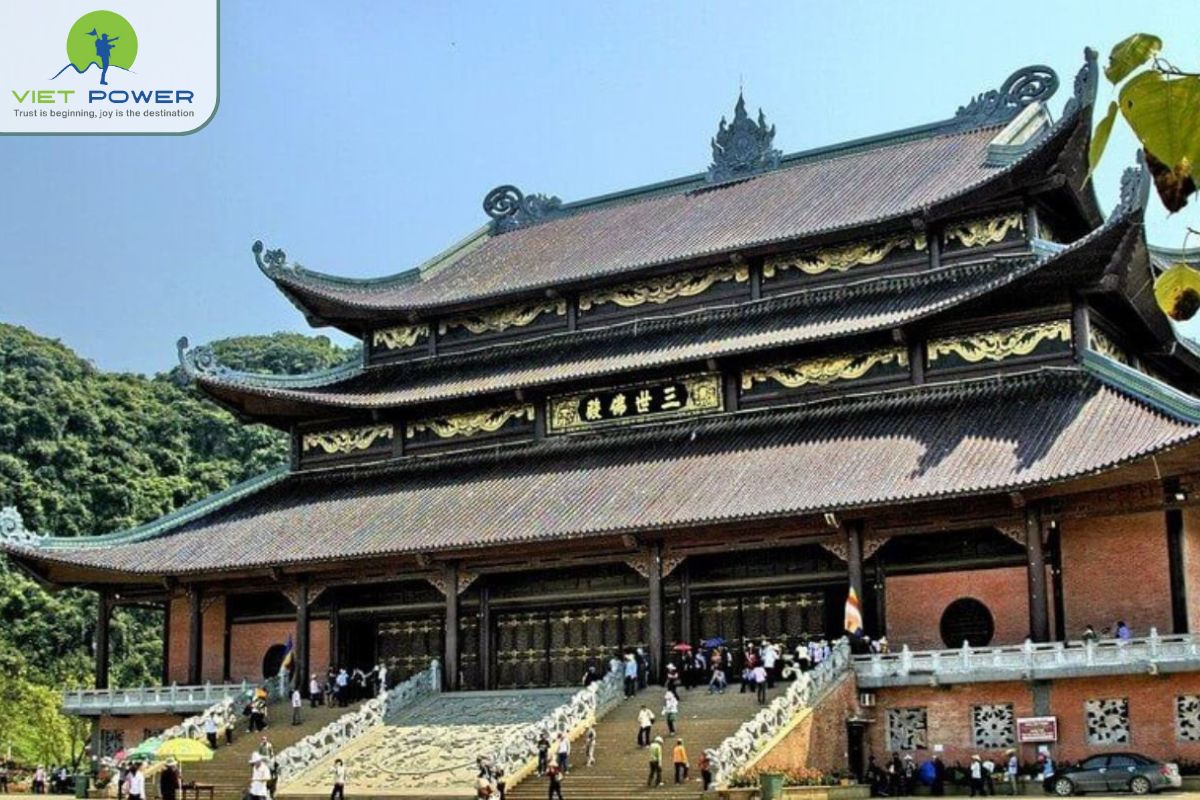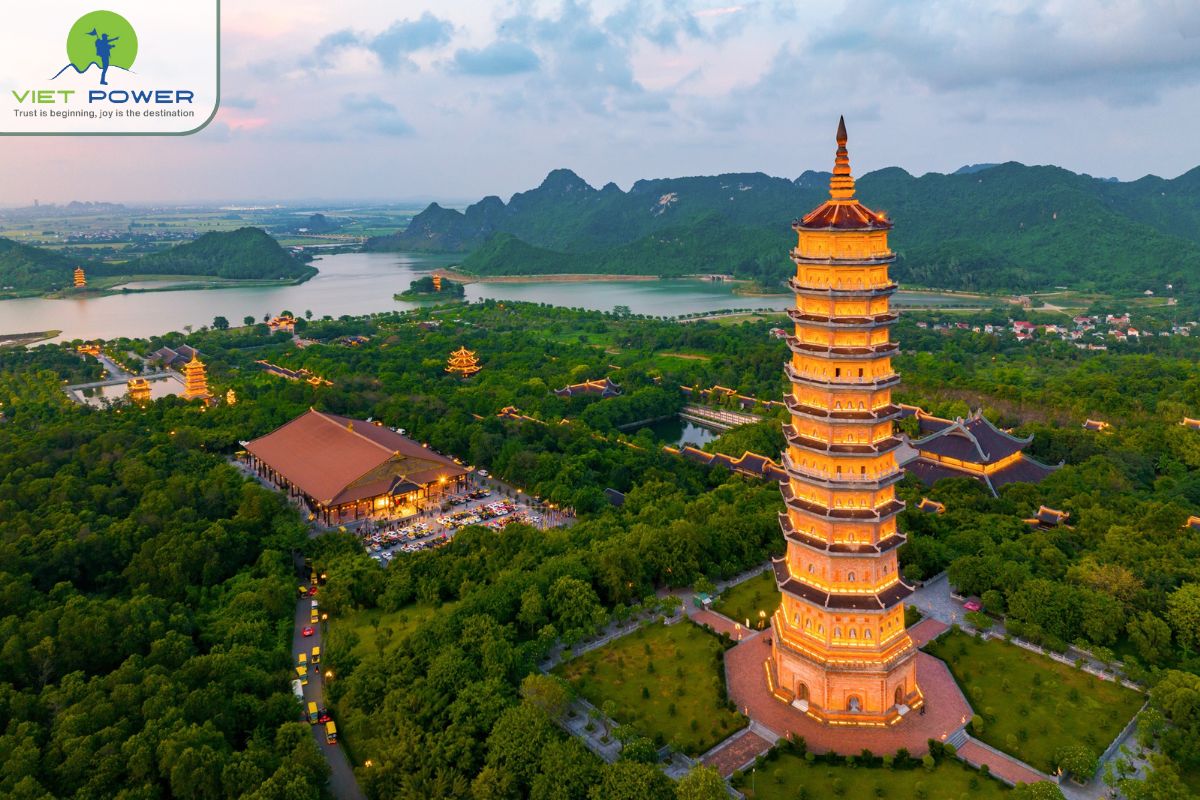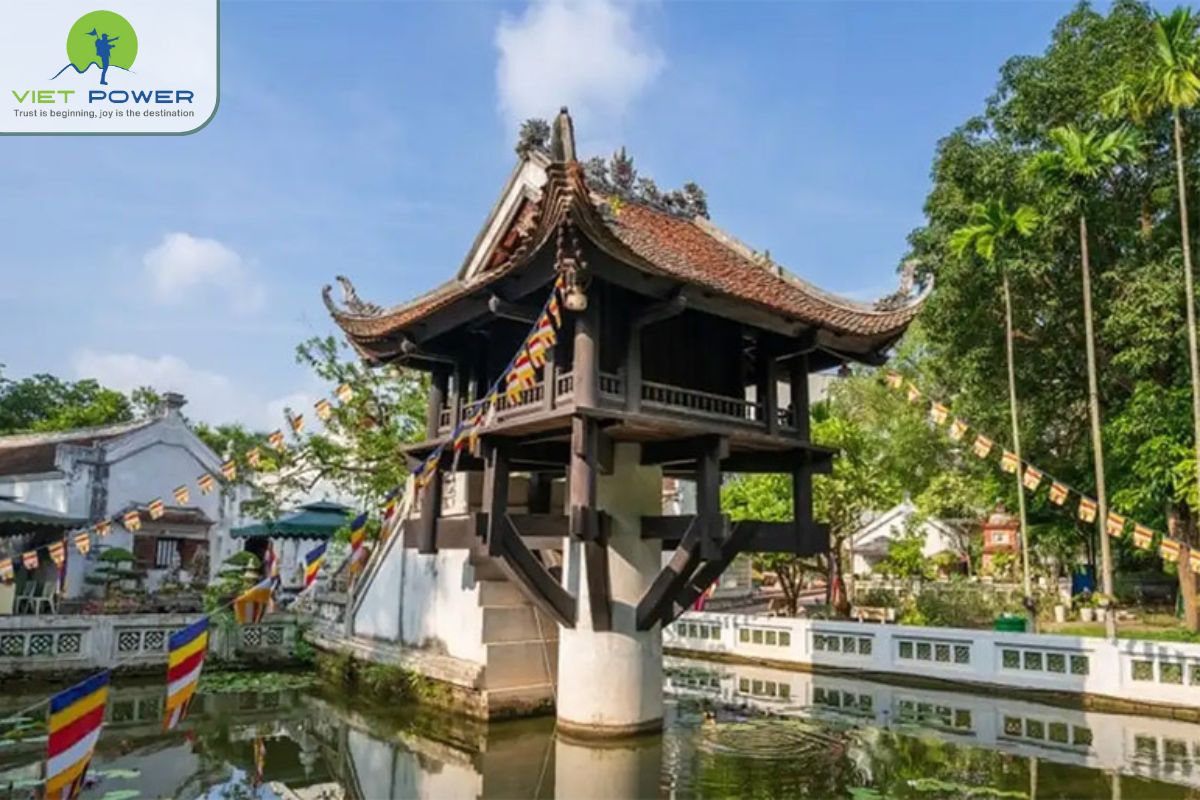Vietnam is famous for its magnificent sacred beauty and rich cultural heritage. Where pagodas stand as a symbol of Vietnam's rich Buddhist heritage. Pagodas are not just places of worship, but also are intrinsic elements of Vietnamese society. Each pagoda tells a unique story through its distinctive history, design and spiritual meaning. In the following post of Vietpower Travel, let’s discover the story of famous pagodas in Vietnam,
Overview of Pagodas in Vietnam
Pagodas in Vietnam are the center of spiritual life. They are where people worship Buddha, monks live to practice Buddhism and people hold religious events. Vietnamese popularly considered Pagodas as places of serenity and reflection. People seek calm, pray for their families' well-being, and remember their ancestors
Vietnamese pagodas are vital pillars of society and cultural preservation besides religious sites. Pagodas serve as community gathering places, particularly during major festivals like Lunar New Year, where people sought good fortune and gave incense. Pagodas also preserve ancient artifacts, statues, and historical inscriptions, chronicling the nation's history and its enduring artistic heritage.
![Overview of Pagodas in Vietnam]()
Every detail of a Vietnamese pagoda's design has symbolic value based on Vietnamese culture and Buddhist teachings. For example, the tiered roof is the most distinctive feature. The corners are typically curved upwards like the tail of a flying dragon or phoenix. The roof is also decorated with intricate carvings, symbolizing a spirit ascending to the heavens and conveying a sense of lightness and grace.
Through their activities, architecture and layout, pagodas in Vietnam distinctly showcase the balance, worldly engagement, and popularization of Vietnamese Buddhism. All the above elements create the nation's unique religious identity.
You can find more posts related to this topic in our Vietnam tourist attractions category. Explore detailed travel guides, destination highlights, and inspiration for your next journey through Vietnam.
About Vietnamese Buddhism: History and Value
We’ve discovered the important role and value of pagoda in Vietnamese society. In this section, let’s explore Buddhism in Vietnam through history and value aspects.
History of Buddhism in Vietnam (2nd century - now)
According to many sources, people believe that Buddhism first entered Vietnam around the 2nd century. There are 2 main routes: via sea from India and Southeast Asia and via land from China into the Red River Delta. This early presence made Vietnam one of the earliest countries in Southeast Asia to embrace Buddhism. At the very first moment, the Vietnamese built the first pagoda for worshiping - Dau pagoda - and nowadays it’s the oldest pagoda in Vietnam.
For centuries of ups and downs, Buddhism reached its peak and became the state religion in 11-13 century. In the feudal period, it became a harmony of traditional belief and Confucianism, rooted deeply in Vietnamese life. Nowadays, Vietnam is a country of religious freedom and Buddhism becomes a spiritual support for people where they come to find the meanings of life.
![Vietnamese Buddhism History and Value]()
Which core value does Buddhism lead people to?
Basically, the core value of Buddhism is free of suffering and reincarnation via practices. The result leads to the state peace known as Enlightenment and reaches Nirvana. Everyone can reach Nirvana by understanding and applying the Four Noble Truths: the truth of suffering and how to reap it off; and Noble Eightfold Path: the ways of practicing the right thing.
Another core value of Buddhism is Karma - the basic rules of the university. We can understand that Karma is the relationship of cause and result. Bad thoughts cause bad actions and lead to bad results. On the other hand, thinking and doing good will lead to good results and a relief of the soul. This value of Buddhism also leads people to live a good life and believe in good things.
For nearly 2000 years, Vietnamese have built many pagodas along the country to worship, seek for peace and meanings of life. Vietnam is home to about 1,800 pagodas, each playing an important role in the country’s spiritual and cultural life. Let’s discover some famous pagodas in the next section.
Famous pagodas in the North of Vietnam
Many pagodas in the North of Vietnam are beautiful tourist destinations. Let’s explore three of the most famous pagodas in Northern Vietnam, each with its own story, history, and charm.
Bai Dinh Pagoda - The largest Pagoda Complex in Vietnam
Located at the western gate of Hoa Lu Ancient Citadel, Ninh Binh Province, around 95 kilometers from Hanoi, Bai Dinh Pagoda is known as the largest pagoda complex in Vietnam. The pagoda is admired for its grand size, traditional Vietnamese architecture, and peaceful atmosphere. Being surrounded by limestone mountains and green valleys which create a perfect blend of nature and spirituality.
Bai Dinh Pagoda is not just a single temple but a massive complex of both ancient and modern pagodas. It is a vast religious site that holds numerous records, both nationally and across Asia.
Records and unique features of Bai Dinh Pagoda:
- The largest pagoda complex in Vietnam
- The largest gilded bronze Buddha statue in Asia
- The largest bronze Maitreya Buddha in Southeast Asia
- The biggest bronze bell in Vietnam
- The tallest stupa in Asia
- The longest Arhat corridor in Asia
- The most Arhat statues in Vietnam
- The largest Pearl Well in Vietnam
- The most Bodhi trees in Vietnam
![Bai Dinh Pagoda - The largest Pagoda Complex in Vietnam]()
In 2010, Bai Dinh Pagoda hosted the Great Buddhist Festival when sacred Buddha relics were brought from India, marking a significant event in Vietnam’s Buddhist history.
Tip for traveling in Bai Dinh Pagoda: Visitors can take electric cars to travel around the vast complex, explore the ancient caves of the old pagoda area, or climb the hill for a panoramic view of the limestone mountains and peaceful countryside of Ninh Binh.
One Pillar Pagoda - The symbol of Hanoi Capital
One Pillar Pagoda, located in Ba Dinh District near Ho Chi Minh Mausoleum and Ba Dinh Square, is one of the most iconic landmarks of Hanoi. The One Pillar Pagoda was originally built in 1049 during the reign of Emperor Ly Thai Tong.
According to legend, the emperor dreamed of the Buddha Goddess of Mercy sitting on a lotus flower. After he told his dream to a monk, he was advised to build a pagoda shaped like a lotus to show his gratitude and devotion.
The pagoda is made entirely of wood and stands on a single stone pillar that is 1.2 meters wide and 4 meters high. On top of the pillar sits a small wooden shrine called Lotus Flower Base, with curved roofs shaped like blooming lotus petals. The structure sits in the middle of a square lotus pond, giving the impression that it is floating gracefully on the water’s surface.
Special facts about the iconic Pagoda in Hanoi:
- Designed to resemble a lotus flower, a symbol of purity in Buddhism.
- Built more than 970 years ago and rebuilt several times after wartime damage.
- One of Hanoi’s most famous landmarks and a national symbol of Vietnam.
![One Pillar Pagoda - The symbol of Hanoi Capital]()
Tip for visiting One Pillar Pagoda: Because of its location near other attractions such as Ho Chi Minh’s Stilt House, the Temple of Literature, and the Presidential Palace, visitors can easily combine a visit to the One Pillar Pagoda with other famous sites in Hanoi.
Dau Pagoda - The oldest Pagoda in Vietnam
Tourists ask: Which is the oldest pagoda in Vietnam? The answer is Dau Pagoda in Bac Ninh Province.
It dates back to the 2nd century when this place was an important trading and cultural center. This area was the first place where Buddhism entered Vietnam, brought by merchants from India and Central Asia. Because of this, Dau Pagoda is often referred to as the cradle of Vietnamese Buddhism.
The pagoda is associated with the legend of the Four Dharma Goddesses. They represent rain, clouds, thunder, and lightning. This story shows how early Vietnamese people combined Buddhist teachings with traditional beliefs about nature. This creates a unique form of local Buddhism. Over the centuries, Dau Pagoda has been repaired many times, but it still preserves ancient towers, old sculptures, and stone inscriptions that reflect the deep spiritual heritage.
The legend of the Four Dharma Goddesses tells of Man Nuong, a virtuous woman who miraculously gave birth to a divine child after meeting the Indian monk. Following the monk’s guidance, she placed the baby beneath a banyan tree, which was later swept away by floods. From the tree’s wood, villagers carved four sacred statues that became the Four Goddesses - Phap Van (Cloud), Phap Vu (Rain), Phap Loi (Thunder), and Phap Dien (Lightning) - each ruling over a natural element vital to agriculture. Worshiped in the Dau region of Bac Ninh, they are honored for bringing favorable weather, fertility, and prosperity to the land.
Why visit Dau Pagoda:
- It is the oldest Buddhist site in Vietnam.
- Represents the beginning of Buddhism in the country.
- Home to ancient towers and stone inscriptions telling stories of early spiritual life.
- Surrounded by other historic pagodas, making it an excellent place for cultural exploration.
![Dau Pagoda - The oldest Pagoda in Vietnam]()
Tip for visiting Dau Pagoda: Visit during the Dau Pagoda Festival, usually held in April according to the lunar calendar, to experience traditional music, rituals, and folk games that celebrate the pagoda’s long and meaningful history.
Famous pagodas in the Central of Vietnam
Central Vietnam is not only famous for its beautiful beaches and ancient cities but also for its impressive pagodas that reflect the region’s long-standing spiritual traditions. Among the most visited and historically important are Thien Mu Pagoda in Hue and Linh Ung Pagoda in Da Nang. Both are symbols of peace and belief, attracting travelers who wish to explore Vietnam’s Buddhist culture while enjoying breathtaking natural views.
Thien Mu Pagoda - The oldest and most iconic Pagoda in Hue
Thien Mu Pagoda, also known as the “Pagoda of the Celestial Lady,” is one of the most famous religious places in Central Vietnam. It was built in 1601 during the reign of Lord Nguyen Hoang. It’s the oldest pagoda in Hue and a symbol of the ancient capital.
Nowadays, it is considered the spiritual heart of Hue and an important part of the city’s history. Only 5 km from the center, its location on Ha Khe Hill gives it a peaceful view over the poetic Perfume River, making it a perfect place for meditation and reflection.
The most recognizable feature of Thien Mu Pagoda is the Phuoc Duyen Tower. It’s a seven-story octagonal tower that stands 21 meters tall. Each floor of the tower is dedicated to a different Buddha, representing the layers of enlightenment. Behind the tower lies the main hall, where visitors can see many valuable Buddha statues, ancient bells, and wooden inscriptions.
Special facts about Thien Mu pagoda:
- Built in 1601, making it over 400 years old.
- The Phuoc Duyen Tower is a symbol of Hue City.
- Home to an antique bell cast in 1710 and a giant marble turtle carrying stone steles.
- It keeps the car of monk Thich Quang Duc, who famously self-immolated in 1963 to protest religious persecution, a powerful symbol of faith and sacrifice.
![Thien Mu Pagoda - The oldest and most iconic Pagoda in Hue]()
Tip for visiting Thien Mu Pagoda: Visitors can take a boat ride along the Perfume River to reach Thien Mu Pagoda, especially at sunset, when the view of the river and temple becomes more serene and beautiful.
Linh Ung Pagoda - The guardian of Da Nang City
There are 3 Linh Ung pagodas in Danang City. However, in this post, we will discover Linh Ung Pagoda in Son Tra Peninsula which is believed to be the guardian of the city. The pagoda’s name “Linh Ung” means “miraculous response” showing the people’s deep faith in Buddha’s compassion.
Linh Ung Pagoda is one of the most important spiritual sites in Central Vietnam and a popular destination for both locals and tourists. It sits on a hill facing the sea, with its back to the mountains. It’s a position that, according to local beliefs, brings peace and protection to Da Nang City.
The pagoda complex covers a large area and combines traditional Vietnamese architecture with modern design. The main attraction is the Buddha Goddess of Mercy statue, which stands 67 meters tall, equivalent to a 30-story building. The statue faces the East Sea and is believed to watch over fishermen and keep them safe during storms. Inside the statue are 17 floors, each with different Buddha altars for visitors to explore.
Special facts about Linh Ung Pagoda:
- The tallest Buddha Goddess of Mercy statue in Vietnam (67 meters high).
- Offers panoramic views of Da Nang City, Son Tra Peninsula, and the ocean.
- Considered one of the three major “Linh Ung” pagodas in Da Nang (along with Linh Ung Non Nuoc and Linh Ung Ba Na).
- A popular place for locals to pray for peace, health, and good fortune.
![Linh Ung Pagoda - The guardian of Da Nang City]()
Tip for visiting Linh Ung pagoda on Son Tra peninsula: Visit Linh Ung Pagoda in the early morning or late afternoon to enjoy the cool breeze and stunning views over Da Nang Bay. The area is also perfect for photography and quiet meditation.
Famous pagodas in the South of Vietnam
Southern Vietnam is famous for its vibrant culture and friendly people, and its pagodas reflect this open-hearted spirit. The pagodas here often blend traditional Vietnamese, Chinese, and Khmer architectural styles. Therefore, this creates colorful and lively spaces for both worship and sightseeing. Among the many sacred sites, Vinh Trang Pagoda and Giac Lam Pagoda stand out as must-visit destinations for anyone interested in religion and culture.
Vinh Trang Pagoda - The most beautiful Pagoda in the Mekong Delta
Vinh Trang Pagoda (Tien Giang Province) is one of the most famous pagodas in Southern Vietnam and the largest in the Mekong Delta region. Built in the early 19th century, the pagoda stands out for its distinctive design, which combines Vietnamese, Chinese, Khmer, and European architectural elements. This creates a harmonious structure surrounded by lush gardens, lotus ponds, and ancient bonsai trees.
From the outside, Vinh Trang Pagoda looks more like a grand villa than a traditional temple. The front façade features Roman-style columns, French floral patterns, and Gothic-style arches, all decorated with bright ceramic mosaics. Inside, the pagoda preserves traditional Asian elements such as wooden carvings, curved roofs, and golden Buddha statues, representing Vietnamese spiritual art.
The pagoda’s most striking feature is its three large Buddha statues: the Standing Buddha, the Reclining Buddha, and the Laughing Buddha. The statues of Buddha symbolize past, present, and future peace. Inside the temple, visitors can see many precious wooden statues, intricate carvings, and colorful mosaics that depict Buddhist stories.
Special facts about the most beautiful pagoda in the South of Vietnam:
- Built in the 1840s and restored several times over the centuries.
- Covers nearly 2 hectares with beautiful gardens and ancient trees.
- The architecture blends Eastern and Western styles, making it unique in Vietnam.
- Home to more than 60 precious Buddha statues made from wood, bronze, and terracotta.
![Vinh Trang Pagoda - The most beautiful Pagoda in the Mekong Delta]()
Tip for visiting Vinh Trang pagoda: Vinh Trang Pagoda is only about 70 km from Ho Chi Minh City. You can easily combine it with a boat trip along the Mekong River to experience both spiritual culture and the charm of the southern countryside.
Giac Lam Pagoda - The oldest Pagoda in Ho Chi Minh City
Giac Lam Pagoda was built in 1744, making it the oldest pagoda in Ho Chi Minh City. It was originally built in the countryside, but over time, the city grew around it. Despite being in a modern metropolis, Giac Lam remains a calm, sacred place where locals come to pray and find inner peace.
The pagoda follows traditional southern Vietnamese architecture with wooden beams, tiled roofs, and a layout shaped like the Chinese character meaning “Three”. It symbolizes the Three Jewels of Buddhism: Buddha, Dharma, and Sangha. Inside the main hall are more than 100 Buddha statues and beautifully carved altars. In the garden stands a tall, white, seven-story stupa built in 1970, where visitors often leave offerings and pray for blessings.
What is special about Giac Lam pagoda:
- Built in 1744, it is the oldest existing pagoda in Ho Chi Minh City.
- Houses over 100 ancient Buddha statues and valuable wooden relics.
- The seven-story stupa is a symbol of purity and enlightenment.
- Recognized as a national historical and cultural site in Vietnam.
![Giac Lam Pagoda - The oldest Pagoda in Ho Chi Minh City]()
Tip for visiting Giac Lam pagoda: Giac Lam Pagoda is located just a short drive from Tan Son Nhat Airport. It’s a great stop for those wanting to experience a quiet, spiritual moment before or after exploring the city’s lively streets.
Conclusion
If you have the chance to visit Vietnam, exploring Vietnamese pagodas is a journey you shouldn’t miss. These sacred pagodas from North to South are not only places of worship but also living centers of spiritual and cultural life. For those who wish to connect more deeply with the country’s spiritual heritage, Vietpower Travel can help design a personalized pagoda tour across Vietnam. With a knowledgeable local guide, you can fully immerse yourself in the culture, understand the meaning behind each sacred site, and focus on your own spiritual journey through the heart of Vietnam.

.jpg) Customize Your Trip
Customize Your Trip








 Vietnam Tours
Vietnam Tours Thailand Tours
Thailand Tours Laos Tours
Laos Tours Indonesia Tours
Indonesia Tours Cambodia Tours
Cambodia Tours Myanmar Tours
Myanmar Tours